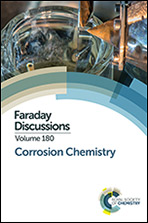Mechano-electrochemistry effects due to deformation of copper oxide films
Abstract
In an attempt to elucidate the relationship and underlying processes of metal oxidation under stress, we combined the electrochemical characterisation with Density-Functional-Theory (DFT) calculations to interrogate the (100) surface of copper. The oxidised (100) surface shows a missing-row reconstruction, which is believed to be driven by surface stress. Hence, additional mechanical stimuli might have a significant impact on the onset of Cu oxidation. We find that different surface sites respond differently to strain. Oads at the thermodynamically favoured high-coordination hollow site (O coordinated to four Cu) is stabilised by up to 130 meV by imposing 2% tensile strain onto the surface, while the low-coordination top site (O coordinated to one Cu) shows a markedly different sensitivity. By cramping into the hollow site, Oads induces compressive stress into the (100) surface, an effect that is largely absent for the adsorption at the top site. We also find that the thermodynamic advantage of reconstructive underpotential surface oxidation is diminished under tensile strain. Hence, imposing tensile stress counter-balances the oxygen induced surface stress, which might have an implication on the onset of bulk copper oxidation. Studying Cu(100) single crystal surfaces in perchloric acid using cyclic voltammetry, we were able to confirm sensitivity of the electrochemical response towards the elastic strain.
- This article is part of the themed collection: Corrosion Chemistry

 Please wait while we load your content...
Please wait while we load your content...